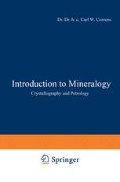Abstract
We are all familiar with the subdivision of the natural world into the plant, animal, and mineral kingdoms. Of these the realm of minerals is the study and research area of mineralogy. A mineralogist uses the word mineral, however, in a much more restricted sense than prevails with common usage. If we examine a rock rather closely, we notice, for example, that a sandstone is composed of individual quartz grains. When we examine a specimen of granite, we can recoginze feldspar, dark mica, and perhaps also hornblende, in addition to quartz. From a specimen of certain ores, galena, chalcopyrite, and sphalerite all shine forth brilliantly. Any such individual rock constituent is a mineral. Mineralogy encompasses the study of these minerals and the manner in which they occur, and includes the properties of all rock materials, which, in the sense used here, embrace ore and salt deposits, as well as other useful mineral deposits.
Access this chapter
Tax calculation will be finalised at checkout
Purchases are for personal use only
Preview
Unable to display preview. Download preview PDF.
Literature
Belov, N. V.: A class-room method for the derivation of the 230 space groups. Translated from the Russian.) Leeds 1966.
Buerger, M. J.: Elementary crystallography. New York-London 1956.
Burckhardt, J. J.: Die Bewegungsgruppen der Kristallographie, 2. ed. Basel u. Stuttgart 1966.
Friedel, G.: Leçons de Cristallographie. Paris 1921.
Goldschmidt, V.: Atlas der Kristallformen. Heidelberg 1913–1926. (9 Volumes with Figures and Tables.)
Groth, P.: Chemische Kristallographie, 5 Volumes. Leipzig 1906–1919.
Groth, P.: Elemente der physikalischen und chemischen Krystallographie. München u. Berlin 1921.
Phillips, F. C.: An introduction to crystallography, 3. ed. London 1963.
Raaz, F., u. H. Tertsch: Einführung in die geometrische und physikalische Kristallographie, 3. ed. Wien 1958.
Schoenflies, A.: Krystallsysteme und Krystallstruktur. Leipzig 1891.
Speiser, A.: Die Theorie der Gruppen von endlicher Ordnung, 4. ed. Basel 1956.
Terpstra, P., and L. W. Codd: Crystallometry. London 1961.
Tertsch, H.: Die stereographische Projektion in der Kristallkunde. Wiesbaden 1954.
Tütton, A. E. H.: Crystallography and practical crystal measurement. London 1922.
Author information
Authors and Affiliations
Rights and permissions
Copyright information
© 1969 Springer-Verlag Berlin · Heidelberg
About this chapter
Cite this chapter
Correns, C.W. (1969). Crystal Mathematics. In: Introduction to Mineralogy. Springer, Berlin, Heidelberg. https://doi.org/10.1007/978-3-642-87134-4_1
Download citation
DOI: https://doi.org/10.1007/978-3-642-87134-4_1
Publisher Name: Springer, Berlin, Heidelberg
Print ISBN: 978-3-642-87136-8
Online ISBN: 978-3-642-87134-4
eBook Packages: Springer Book Archive

